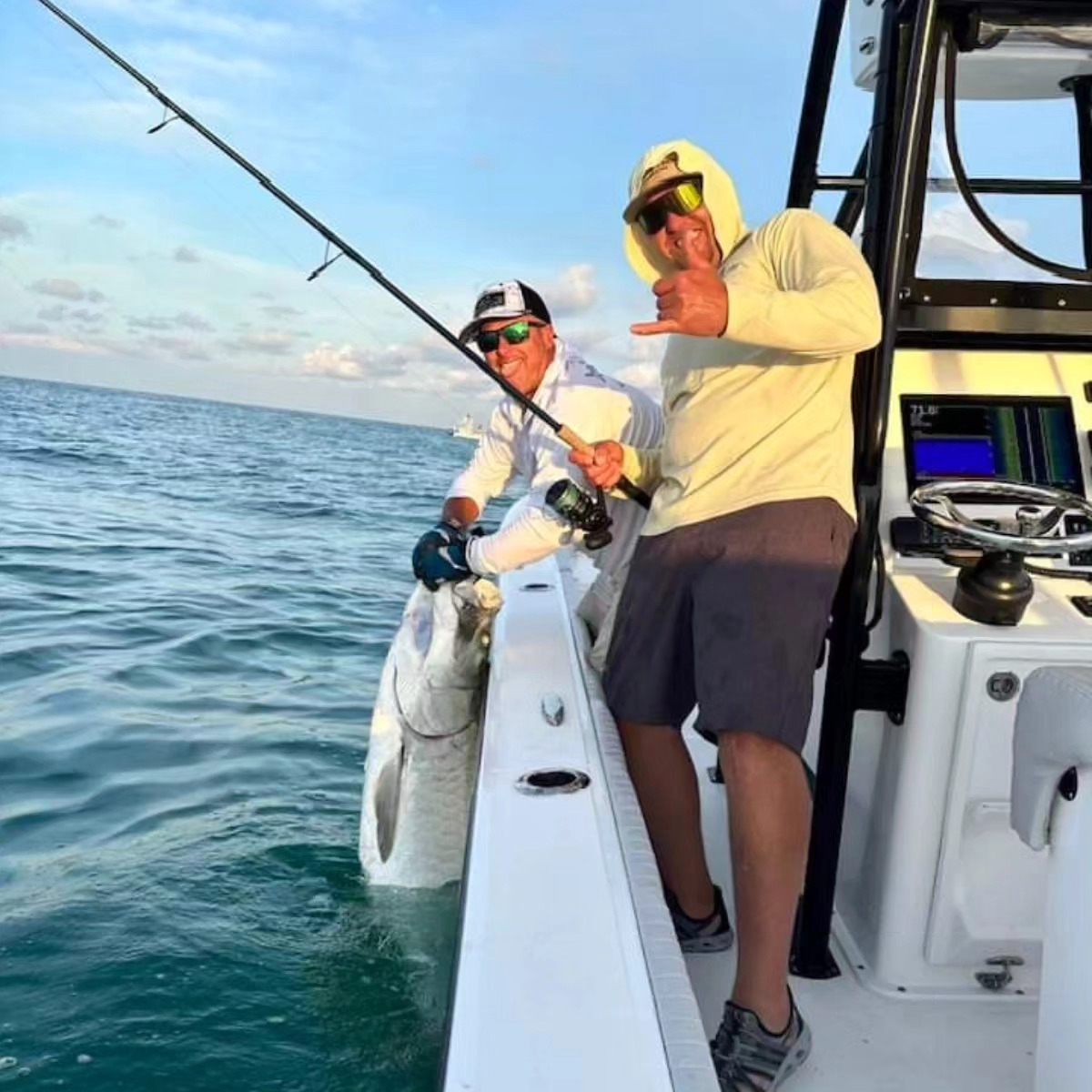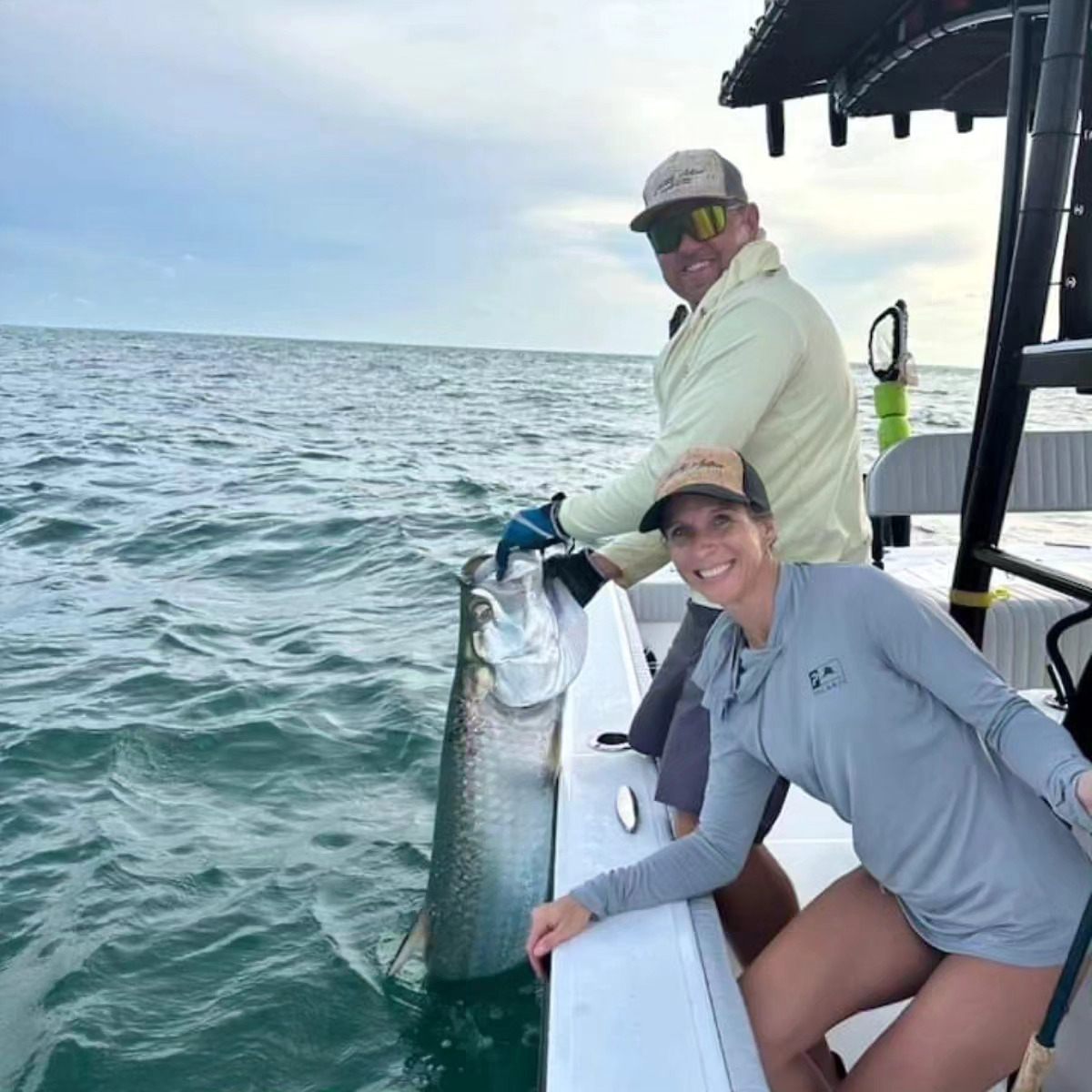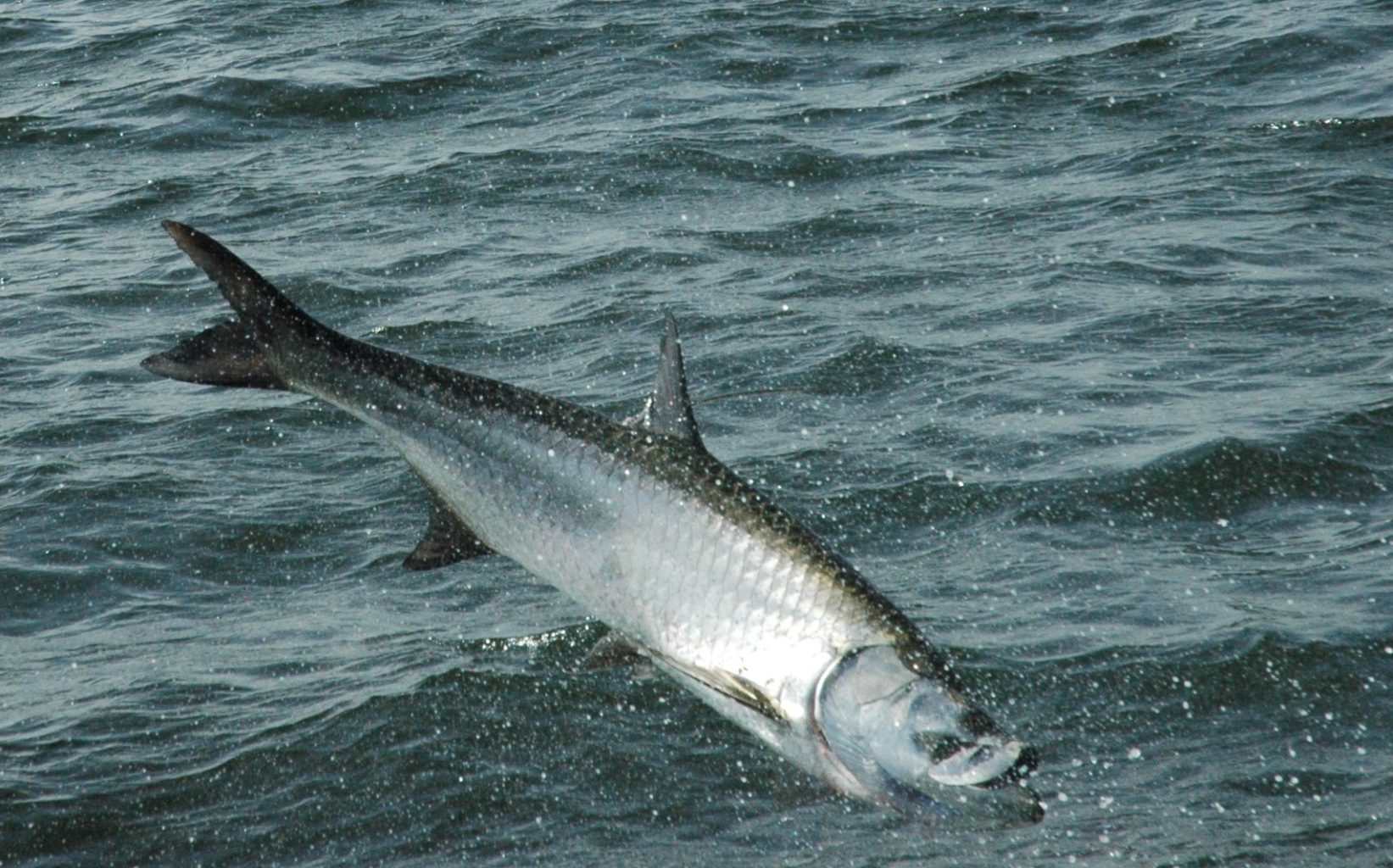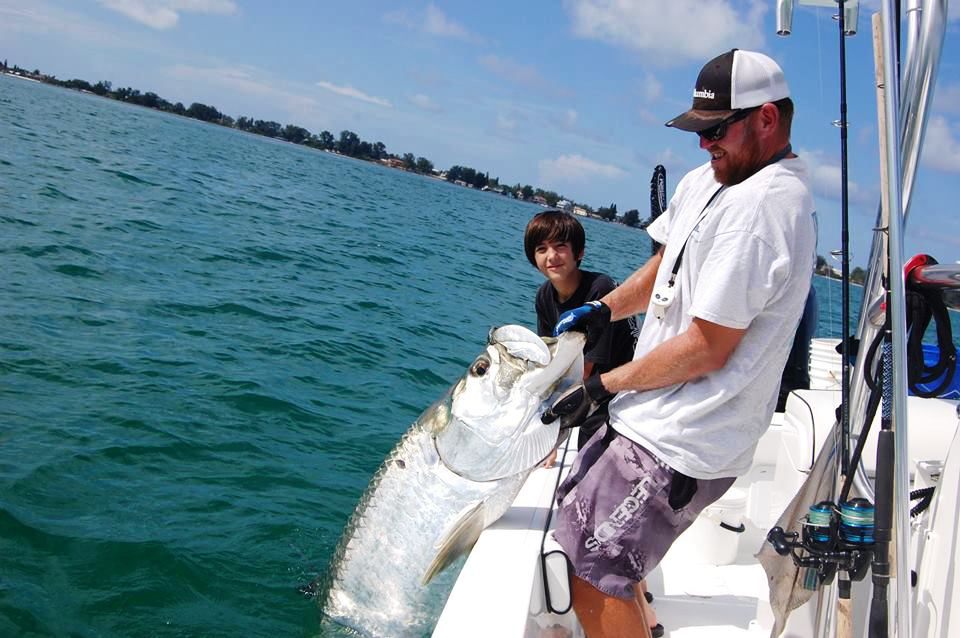By using our website, you agree to the use of cookies as described in our Cookie Policy
Home › Fish We Catch › Tarpon Fishing
Tarpon are in a class of their own. Clients come from all over the world to target the Silver King, and to feel the raw power and fight.
Home › Fish We Catch › Tarpon Fishing

Tarpon fishing unleashes an electrifying surge of adrenaline like no other! Once you’ve got one on the line, brace yourself for an exhilarating rollercoaster ride of epic proportions. Get ready to witness a heart-pounding spectacle as the drag screams and line peels off with lightning speed, launching you into an adrenaline-fueled frenzy. Suddenly, the water erupts in a breathtaking display of raw power, as the tarpon propels itself skyward, defying gravity with mind-blowing acrobatic leaps that defy belief! These colossal leaps, reaching heights of 5 to 10 feet, will leave you awe-struck and yearning for more.
But the battle has only just begun, my friend. As you hold on for dear life, your gear, your angling prowess, and your unyielding spirit will all be pushed to the absolute limits. This is the ultimate test of skill, strength, and sheer determination. Each passing second feels like an eternity as you engage in an epic clash of wills, where only the most tenacious prevail.
Amidst the chaos, you’ll discover what you’re truly made of. The pounding of your heart echoes the relentless fight pulsating through your veins. Your gear strains under the immense pressure, its resilience pushed to the edge. The angler’s mettle is tested, as every muscle strains and every ounce of concentration is focused on a single goal: emerging victorious from this primal showdown.
In this gripping battle, there is no room for weakness. The fate of triumph or defeat hangs in the balance, and you, my friend, must ensure that you are the unbreakable link that defies all odds. Embrace the thrill, savor the challenge, and seize the opportunity to etch your name in the annals of legendary tarpon anglers. This is the epitome of excitement, an adrenaline-soaked quest where ordinary limits are shattered, and extraordinary tales are forged. Welcome to the electrifying world of tarpon fishing—where legends are born and unforgettable adventures unfold!
The tarpon, also known as the "silver king," is a fascinating species. These majestic fish possess a streamlined body covered in large, shiny scales that reflect the sunlight, giving them a stunning silver appearance. Tarpons can grow to impressive sizes, reaching lengths of up to 8 feet and weighing over 200 pounds. One of their most remarkable features is their large, upward-facing mouth, equipped with a strong jaw and a set of sharp, inward-curving teeth. This unique mouth structure allows them to engulf and crush their prey effectively. Additionally, tarpons have a prominent dorsal fin and a deeply forked tail, which provides them with exceptional maneuverability and speed in the water. With their remarkable anatomy, tarpons are well-adapted to their marine habitat and continue to captivate anglers and nature enthusiasts alike.
The tarpon, also known as the "silver king," is a fascinating species. These majestic fish possess a streamlined body covered in large, shiny scales that reflect the sunlight, giving them a stunning silver appearance. Tarpons can grow to impressive sizes, reaching lengths of up to 8 feet and weighing over 200 pounds. One of their most remarkable features is their large, upward-facing mouth, equipped with a strong jaw and a set of sharp, inward-curving teeth. This unique mouth structure allows them to engulf and crush their prey effectively. Additionally, tarpons have a prominent dorsal fin and a deeply forked tail, which provides them with exceptional maneuverability and speed in the water. With their remarkable anatomy, tarpons are well-adapted to their marine habitat and continue to captivate anglers and nature enthusiasts alike.
I always like to have plenty of chum to get the Snapper up off the bottom. This can be done by catching a bucket of chum after filling the livewell up with live baits. If bait is hard to catch you can buy a chum block at the bait shop. Another option is to use some frozen shrimp or any other type of frozen bait you may have. The idea is to bring the Snapper to you.
Fishing around the tides is another key to success with Mangrove Snapper. Look at a tide chart and try to plan your trips around the slower tides. If you are fishing around stronger tides then you want to try and plan the Snapper fishing around the start and stop if the areas you plan to fish have a lot of tide. During the stronger tides plan to fish areas that don’t have so much current. The idea is to use the chum to draw the fish off the bottom.
Another great tip is using a great sonar with side imaging to find the rock piles and ledge in the area you are fishing. This mixed with a GPS trolling motor will make life easier and put more fish in the boat. Since switching my electronics to include side imaging, I have increased my productivity of Mangrove and all bottom fish productivity.
Use a Fluorocarbon lighter leader. I like to start with about 3 feet of 20lb leader but if the Snapper are not biting try to downsize to15 lb. I also try to use the Daiichi #1 circle hooks as well. Smaller tackles will result in more hookups. Snapper fishing can be very challenging at times as they are very picky. Using lighter gear will make free spooling the baits easier and also a rod with a sensitive tip will ensure you feel the bite. I typically use my St Croix inshore Mojo rods medium action.


The tarpon fishing season in Southwest Florida typically runs from late spring to early fall, spanning from April to September. During this period, large numbers of tarpon migrate along the coast, feeding on the abundance of baitfish and crustaceans. May, June, and July are considered the peak months when tarpon concentrations are at their highest, providing anglers with the best chances for successful encounters.
Tarpon are warm-water species, preferring water temperatures between 75 to 85 degrees Fahrenheit. In Southwest Florida, these optimal temperatures are usually achieved during the summer months. Monitoring water temperatures and paying attention to weather patterns can be instrumental in determining the best days to target tarpon. A stable and consistent rise in water temperatures, combined with favorable weather conditions, can create the ideal environment for tarpon feeding and migration.
Understanding the impact of tides and moon phases on tarpon behavior can significantly improve your fishing success. Many anglers swear by fishing during outgoing tides, as tarpon tend to gather near passes and channels, eagerly awaiting the tidal flow to ambush their prey. Additionally, some believe that fishing around the new or full moon phases can heighten tarpon activity, as they are naturally attuned to the lunar cycles.
One of the preferred gear setups we use for tarpon fishing is the combination of the Daiwa 8000 BG reels paired with a St Croix MOJO extra heavy 8-foot spinning rod. These rods offer the ideal balance of strength and sensitivity necessary to handle the powerful runs and aerial acrobatics of tarpon. To maximize the performance of this setup, we spool the reel with 65-pound braided line, providing excellent strength and sensitivity for detecting bites and maintaining control during the fight.
To ensure a reliable connection to the fish, anglers often use a 60-pound fluorocarbon leader. Fluorocarbon is known for its low visibility underwater and excellent abrasion resistance, which are crucial when targeting tarpon. By using a leader of this strength, you can confidently handle the intense battles with tarpon while reducing the risk of break-offs.
When it comes to hooks, we prefer using Daiichi circle hooks in sizes 5/0 to 6/0. Circle hooks are designed to increase the likelihood of hooking the tarpon in the corner of the mouth, minimizing the chances of deep hooking and facilitating safe catch-and-release practices.
In certain scenarios, such as fishing pods on the beach, we may choose to add a float to the setup. This allows for presenting baits at specific depths, keeping them suspended in the strike zone.

Tarpons are typically 100lbs and up, they fight till near death so preserving the fish and proper holsering of the fish is key for a successful release. There are some ways you can help Tarpon have a successful release.
Utilize tackle that provides sufficient strength and power to handle the size and strength of tarpon. Lighter rods may prolong the fight, putting unnecessary stress on the fish and potentially leading to fatigue or injury.
Minimize the time that the tarpon spends out of the water. Be prepared with cameras and other equipment beforehand to capture the moment efficiently. Remember, the goal is to return the fish to the water as soon as possible.
Instead of bringing the tarpon into the boat, keep the fish alongside the boat for quick photos or measurements. Handling the fish in the water reduces the risk of injury and allows for an easier release.
After the catch, support the tarpon in the water and use the boat's motor (in gear) to gently create water movement over the fish's gills. This helps oxygenate its system and aids in its recovery. Be patient and ensure the tarpon has regained its strength before releasing it.
By following these guidelines, we contribute to the successful release and preservation of tarpon. Remember, these magnificent fish play a vital role in the ecosystem, and practicing responsible angling ensures their continued presence for future generations of anglers to enjoy.


We would love to take you on a fishing charter in Tampa Bay. Give us a call or click below to book your own charter today!
Join Captain Jason Prieto on a fishing charter in the Tampa Bay area with Steady Action Fishing Charters. Our specially-built bay boats with powerful engines take you quickly to the best fishing spots in Tampa. We welcome all skill levels, from beginners to expert anglers, providing quality fishing gear and prioritizing your comfort and safety. Catch popular fish like redfish, snook, mangrove snapper and tarpon. Book your Tampa Bay fishing charter with us today and create lasting memories!
By using our website, you agree to the use of cookies as described in our Cookie Policy